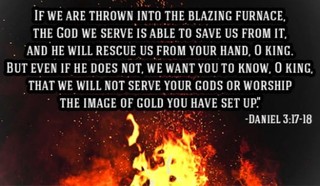- Recent Translations
- All Translations
Daniel 3:2
Share
Settings
Daniel 3:2 Meaning and Commentary
Then Nebuchadnezzar the king sent to gather together the
princes
He sent letters, or dispatched messengers, into the several provinces of his empire, and parts of his dominions, to convene all the peers of his realm, and governors of provinces, and all officers, civil, military, and religious, expressed by various names and titles: the governors, and the captains, the judges, the treasurers, the
counsellors, the sheriffs, and all the rulers of the provinces;
who are particularly and distinctly designed is not easy to say. Jacchiades thinks they answer to the same offices and officers which now obtain in the Turkish empire; princes are the "bashaws"; governors the "beglerbegs"; captains the "agas" of the janizaries; judges the "kadies"; treasurers the "dephterdaries"; the counsellors the "alphakies"; and "zayties the sheriffs"; their chief doctors their "muphties", as L'Empereur; and the rulers of the provinces the "zangiakies" or "viziers"; but, be they who they will, they were the principal men of the empire, both in things civil, military, and ecclesiastic, who were ordered to come to the dedication of the image, which Nebuchadnezzar the king
had set up;
for though it was made and set up, it was not a proper object of worship till dedicated; and which was done by burning incense, blowing trumpets now these great men were gathered together on this occasion, because of the greater honour done hereby to the king and his image; and also by their example to engage the populace the more easily to the worship of it; and likewise as being the representatives of them since they could not all be collected together in one place; and it may be it was done, as some think, to ensnare Daniel and his companions. Philostratus F6 makes mention of an officer at Babylon that had the keeping of the great gate into the city; which some take to be the same with the first sort here mentioned; who first offered the golden statue of the king to be worshipped before he would permit any to enter into the city, which perhaps might take its rise from the worship of this golden image.
F6 De Vita Apollonii, l. 1. c. 19.
